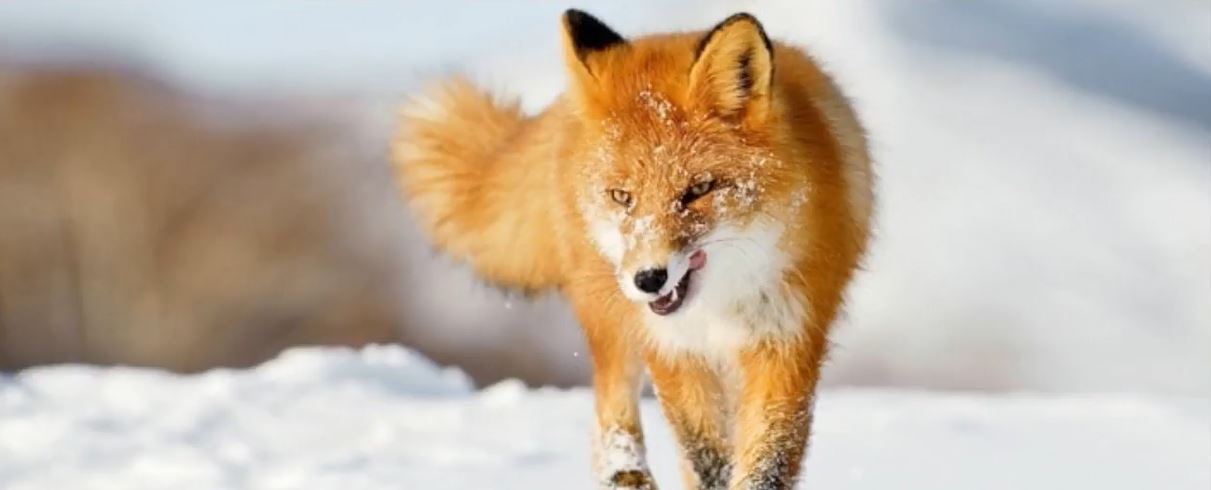About Foxes

The fox is a small- to medium-sized omnivorous mammal that belongs to several genera of the Canidae family. Twelve species belong to the Vulpes genus of “true foxes.” The fox has a flattened skull, triangular ears, a pointy nose, and a bushy tail. They can be found on every continent with the exception of Antarctica. The most common fox is the red fox, of which there are 47 subspecies. They have the reputation of being cunning and because of this, they have made their way into folklore and popular culture. Male foxes are known as dogs, tods, or reynards. Females are known as vixens, and the young ones are called cubs, pups, or kits. A group of foxes is known as a skulk, a leash, or an earth.
The red fox is the largest of the foxes and can weigh anywhere between nine and 19 pounds. The smallest is the fennec fox that weighs just 1½ to 3½ pounds. Depending on species, a fox's coat can be white, black and white, black flecked with white, gray, or auburn. The coat thickens as winter approaches, then is shed come springtime.
Life Cycle
The fox's average life span is one to three years, although some have been known to live for up to ten years. They don't necessarily run in packs but do live in small family groups.
Mating takes place during the winter. The pups from the previous spring leave their birth area. Males follow females closely and fights can ensue. Toward the end of winter, the females look for a suitable birthing den. They don't seem to be too picky, and will use the abandoned dens of other animals, buildings or garden sheds, hollow trees, or find a spot amidst the low-hanging branches of dense trees.
Gestation lasts 52–53 days, somewhat less than that of a domestic dog. The average litter size is four or five. However, Arctic foxes can have up to 11 kits. The kits are born blind and deaf, with short, black fur. Their eyes and ears open when they are two weeks old. They don't leave the den for several weeks and need their mother's warmth.
During this time, the male fox brings food to the female. After three weeks or so, the female will leave the den for increasingly longer periods of time. The kits begin to explore the world outside their den when they are about a month old. They also begin to eat solid food, so all the adults in the family are busy bringing in food. The adults begin their spring molt at this time, too.
As summer begins, the mother fox weans the kits and they all abandon the den. Gradually the juveniles learn to hunt for themselves as the parents reduce the amount of food that they provide for them. The family starts to spread over a larger area by the end of summer.
By autumn, the kits are full-grown and mostly indistinguishable from their parents. Fighting may break out and some of the young ones set off to find their own territories. During autumn and early winter, the new coat grows in on the adults who molted earlier in the year. Their coats are the most beautiful and luxurious now and that is why they are hunted at this time of year. With the onset of winter, mating occurs again, completing the fox's life cycle.
Habitat
As mentioned earlier, foxes can be found around the world except for Antarctica. They can be found in the desert, forests and mountains, and grasslands. They seem to adapt easily to living near people, and can be found on farms, in suburban areas, and even in large communities. They forage for food that people throw out. Some people even feed them.
Diet
Foxes will eat a wide variety of foods that include rats, mice, groundhogs, grasshoppers, snails, berries, eggs, corn, fruit, potatoes, acorns, grass, bread, and chickens. Contrary to what some people claim, their main diet is mice, not sheep or chickens. They have incredibly sensitive hearing and can hear mice or other small rodents running through the grass. The fox jumps into the air and lands where it heard the mouse.
Behavior
The fox hunts solo, walking at the edge of fields or on forest paths, listening for the sound of a mouse in the leaves or grass. At the sound of their prey, a fox leaps into the air and pounces on the unlucky victim. This is a skill that the young fox must learn at an early age. Foxes are good nocturnal hunters because they have eyes that are specially adapted for night vision. A fox's eyes glow green when a light is shone into them at night. Foxes have also been known to climb trees and lay down on a low branch.
Read the Pest Wildlife Home Page page for helpful information and to learn more about About Foxes

